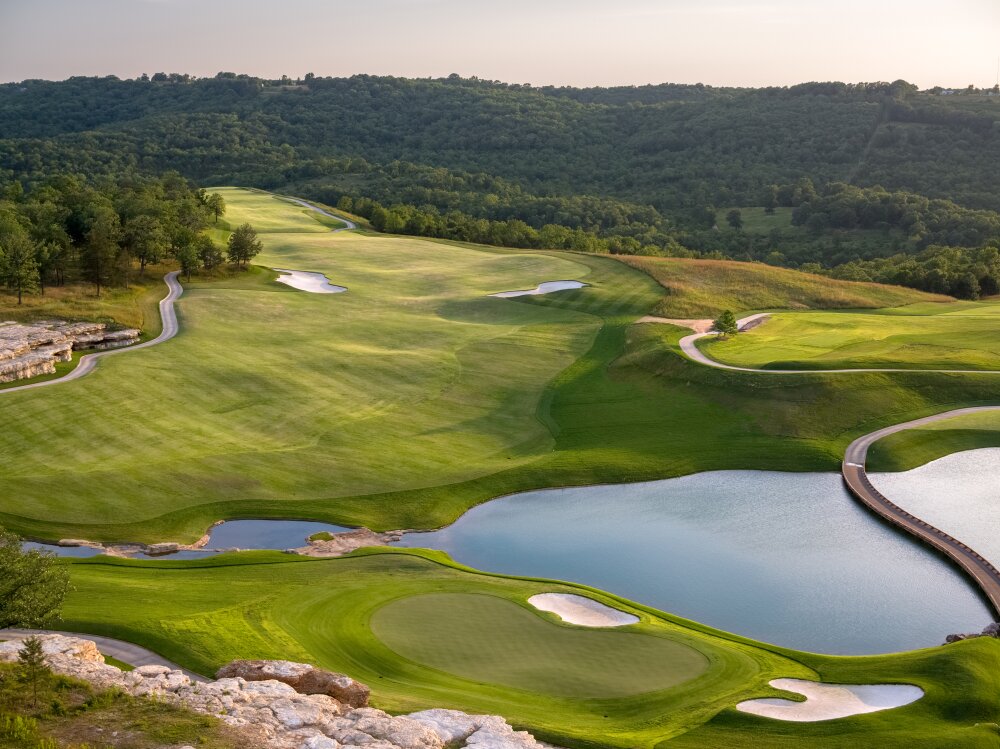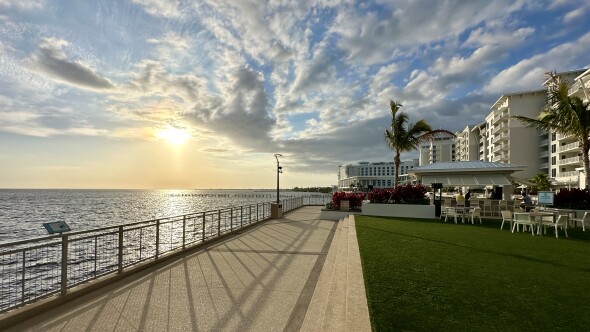HOLLISTER, Mo. — Tiger Woods, the architect, really wants you to have a good time. That was the main takeaway after experiencing the 13-hole preview loop of his first U.S. public course, Payne's Valley, in early August.
Tiger is not used to sharing the spotlight, but he'll have to earn his stripes in the field of design. Payne's Valley opens the same year as Bandon Dunes' new Sheep Ranch, by Coore & Crenshaw. His design will be compared to another C&C offering just steps from his own: Ozarks National. He's also designing the new short course set to open at Pebble Beach.
Payne's Valley, named in honor of Missouri's own Payne Stewart, is the third, full-length 18-hole course at Big Cedar Lodge, Johnny Morris' 4,600-acre Ozarks resort. In a relatively short time, Morris has turned the property into one of the top American golf destinations. It's certainly got a unique offering with two short courses, three full-length courses and a spectacle of a driving range.
So, how does Payne's Valley stack up?
The Payne's Valley experience
Payne's Valley plays next to Mountain Top, the 13-hole, walking-only short course design by Gary Player. Arriving at the bag drop at dawn is surreal as shadowy, untouched hillsides slowly reveal themselves to sunlight. Green slivers of fairway stretch across distant Ozarks ridgelines.
First impression at the bag drop of the Mountain Top - Payne’s Valley clubhouse will get you jacked up to swat golf balls @BigCedarLodge pic.twitter.com/NrtGb3g5ho
— Brandon Tucker (@BrandonTucker) August 2, 2020
It's easy to see some serious earth moving and effort was required to assemble golf holes up here at an elevation of up to 1,300 feet. But the nearly finished product reveals seemingly effortless hole corridors crafted in a routing that is surprisingly walkable given the severity of the surrounding terrain. From the clubhouse, it's a short jaunt down a gravel path to the secluded first tee. The opening view tickles the senses: a straightaway, downhill par 4 with a big fairway and even bigger green valley beyond.

Tiger wants to give you a little comfort out of the gate with a collection of holes that all head gently downhill. It isn't until the 7th that you're finally on a tee box looking up to a fairway and green. There are plenty of birdie chances but the best for recreational players may be on the chip-shot, downhill par-3 10th, which plays between 120 and 140 yards from the middle-back tees. A waterfall rushes behind it and after putting out, you'll walk or drive your cart along a bridge over it. A Johnny Morris staple is entertaining cart rides, and Tiger's design with lead associate Beau Welling takes it to heart with paths that wind through outcroppings, bridges that curve over water, cruise across waterfalls and dance along ridgelines.
Based on what I've experienced at Tiger's private Bluejack National in Texas and now Payne's Valley, the TGR way appears to be broad shaping, ever-so-few trees to worry about and continual expanses of green with tee boxes blending right into the fairway. On the par-5 4th, I found myself hitting a layup about 50 degrees right of the green in order to give myself a good angle across water into a back left pin (it felt a little like a layup strategy of the 15th hole of a certain course in Georgia he's fond of). Landing areas are generous - there are over 80 acres of fairway - with big, round and crisp bunkers that are nevertheless avoidable, especially if you take smart lines of play. The greens are huge with some movement, but they lack severe slopes or fall-offs. Adding to the general pleasantry is the tough, Meyer zoysia turf blades push-pressing your orb up into a plush fairway lie. Zeon zoysia surrounds allow for easy putting and bump-and-runs. There are some little clusters of rough areas, in many cases intended to slow down scooting strays.

So while Payne's will measure 6,700 yards from the middle-back tees and tip out at over 7,200, it will play a few hundred yards shorter, with 450 feet of elevation change and much more of it going downhill than back up. Low handicappers will separate themselves at Payne's Valley with powerful tee shots and aggressive lines off the tee and the ability to execute approach shots typically on slightly sloping ground to greens at a different elevation.
Tiger's quest to catch Jack Nicklaus' 18 majors is among the most documented goals in sports. Woods is charting a very different course with his design style. When you consider the infamous reputation Nicklaus' 1980s designs earned, perhaps a product of the era ushered in by the mad genius of Pete Dye, it is clear that Tiger isn't as interested in such a penal philosophy. Visiting golfers will adore the scenery and playability of Payne's Valley. They'll likely find Ozarks National to be bolder and the Tom Fazio-designed Buffalo Ridge Springs a little tougher.
For the time being, golfers can only play holes 1 through 13 at Payne's Valley. Perhaps the holdup is the big reveal: a 19th hole rumored to be a spectacle. At the time of my visit there was some serious excavating going on in the rock beneath the clubhouse. What do Johnny and Tiger have up their sleeve?
Payne's Valley and Branson golf: What you need to know
The latest from Big Cedar is that Payne's Valley preview play will close on September 12th and will open the full 19-hole experience on September 24th. The current $195 preview green fee includes cart, range balls at Ozarks National and a baggie of snacks. Payne's 19-hole green fee for 2020 is $225. While the course is cart-path-only at the moment, it will be available to walk with shuttles to and from the clubhouse.
For COVID-19 operational updates at Big Cedar Lodge, visit their coronavirus page here.
Big Cedar Lodge is a great all-encompassing golf resort for the outdoor lover. But if you want to take in the sights and sounds of Branson, you'll want to consider staying off-property. The Hilton in downtown Branson is in a festive location next to Branson Landing, featuring a collection of bars, restaurants and shops along the waterfront. Guest rooms are spacious with fantastic beds and huge HDTVs. The hotel has golf packages and preferred rates at Branson Hills Golf Club, considered among the best non-Big Cedar experiences in the area.












Very sad.
I thought the golf world was trying to get more golfers involved in the game and make it more accessible. This is terrible. And I thought tiger cared about the kids and people that don’t have a ton of money. they should make the green fee $50 or less. Seriously.
It seems tiger is really interested in making the average golfer have an enjoyable experience. This is great for someone like myself, a 20
handicapper at 85 years old.
I agree with all who feels that the price is taking a lot of average golfers out of even playing there. Seems to be for the rich since a lot of people can’t just drop $200+ to play plus stay there.
Fabulous review. Has a date been set for the opening of all 19 holes in 2020? The weather may work against them for an opening after Halloween.
Interestingly there is a set date for the closing of the preview loop, but no official opening date for the total course.
It's nice to someone designing a course that is not torture for the average golfer, but $225 to play a round of golf is something I would never consider. There are too many nice courses you can play for way less. A shame that so many resort courses have raised their prices to the point that a golf week is out of the question for many.
I totally agree. Catering to the wealthy. If trying to bring in the younger crowd, then make it fun including affordable.
The day I was there, a fairly large buddies trip of early-30-something guys were at Ozarks National. Honestly the $225 is relatively affordable compared to the top US resort courses. $195 for Ozarks National, in my opinion, is quite good value.
Last week I played the Crenshaw/Coore Cliffside course at the Omni Barton Springs Resort (think it was included in a recent GA article if not mistaken). Fabulous course, scenery, etc. Was supposed to be $139, I paid $69 because I was there with a member. I have been on Bali Hai in Vegas, another great course that would have to be considered a resort course... for just over $100.
$200+ a round? Pass.
Sorry, for the majority of rank & file golfers, two+ Benjamins is not "good value" or affordable. Comparing it to the forever, grossly overpriced PBR and its ilk is a nice PR exercise for Comcast/NBC and its coterie but all it does is perpetuate the elitist nature of the game, especially in the US, and further it's decline. To put things in perspective, a pedestrian resort track like this (no offense meant to TW or any other designer) costs almost as much as the Old Course in peak season and is much more expensive in the shoulder and off seasons. Sorry, if I had to make a choice, I'd take my savings over two-three years, fly cattle and go play the Old Course any time. That's "quite good value" IMO.
This is a thoughtful piece centered on course design by the two greatest all-time golfers, who may or may not fare as well in the historical annals as architects.
Growing up, I was a complete Nicklaus fan—and will always be for many reasons—although I liked many other touring pros from the 70’s/ early 80’s era (including Watson, Trevino, Weiskopf, Miller, Irwin, Ballesteros). And while I like, appreciate, and respect what he’s done as an architect, the body of architectural work hasn’t matched his supreme golfing skills—although it’s hard to critique his landmark courses, designed to test the best, like Muirfield Village.
While I do think the designer Nicklaus has had in mind the average player, to some extent, his foremost design considerations have been for good and excellent and great players. These players largely inform the playability of his creations, at least on the Nicklaus courses I’ve encountered. They are certainly terrific layouts that I’ve enjoyed . But I’ve played with and watched average players toil and struggle on them, in the end often cursing their difficulties.
I’ve never played a Tiger Woods-designed course, but your pictures and descriptions are revealing. I’m glad to hear, from what I’m inferring about his philosophy, that he’s going more in the direction of Doak than Dye or Nicklaus.
Good thoughts there, thanks for sharing. I would say Doak's greens have a lot more going on than what I've seen from Tiger so far at Bluejack and Payne's.
Interesting comment--thanks for making that distinction. From the one Doak course I've played, I came away with the feeling that there was no facet of course design that the man hadn't mastered.